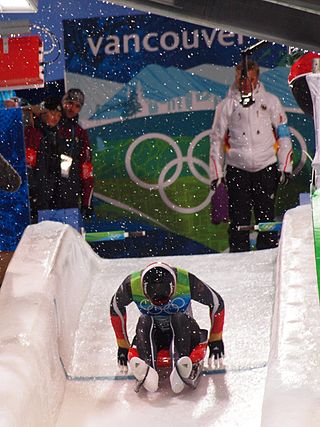
A luge is a small one- or two-person sled on which one sleds supine (face-up) and feet-first. A luger begins seated, propelling themselves initially from handles on either side of the start ramp, then steers by using the calf muscles to flex the sled's runners or by exerting opposite shoulder pressure to the pod. Racing sleds weigh 21–25 kg (46–55 lb) for singles and 25–30 kg (55–66 lb) for doubles. Luge is also the name of an Olympic sport that employs that sled and technique.
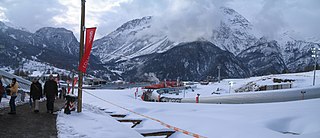
Cesana Pariol was the venue for bobsleigh, luge and skeleton during the 2006 Winter Olympics in Turin, Italy. The track, built for the games, is located in Cesana. The venue holds approximately 7,130 spectators, of whom 3,624 are seated.

The International Luge Federation is the main international federation for all luge sports. Founded by 13 nations at Davos, Switzerland in 1957, it has members of 53 national luge associations as of 2009 and is based in Berchtesgaden, Germany. In reaction to the 2022 Russian invasion of Ukraine, in March 2022 the FIL banned all Russian athletes, coaches, and officials from its events, suspended all Russian officials appointed to its Commissions and Working Groups, and deemed Russia ineligible to host any of its events.
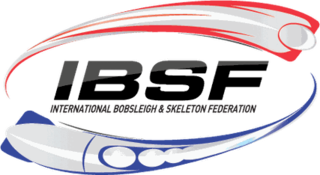
The International Bobsleigh and Skeleton Federation (IBSF) is the international sports federation for the sliding sports of Bobsleigh and Skeleton. It was founded on 23 November 1923 by the delegates of Great Britain, France, Switzerland, Canada, and the United States at the meeting of their first International Congress in Paris, France. In June 2015, it announced a name change from FIBT to IBSF. The federation's headquarters are in Lausanne, Switzerland.

Susi-Lisa Erdmann is an East German-German luger and bobsledder who competed from 1977 to 1998 in luge, then since 1999 in bobsleigh. She was born in Blankenburg, Bezirk Magdeburg. Competing in five Winter Olympics, she won two medals in the women's singles luge event with a silver in 1994 and a bronze in 1992, and a bronze at the inaugural two-women bobsleigh event in 2002. She is one of only two people to ever win a medal in both bobsleigh and luge at the Winter Olympics; Italy's Gerda Weissensteiner is the other.
The FIBT World Championships 2011 took place 14 February – 27 February 2011 in Königssee, Germany, for the fifth time, doing so previously in 1979, 1986, and 1990 (skeleton), and 2004. In 2007, the championships were awarded to Cortina d'Ampezzo, Italy over Winterberg Germany, but Cortina withdrew in February 2009 to issues with the city of Cortina.

The Oberhof bobsleigh, luge, and skeleton track is a venue used for bobsled, luge and skeleton located in Oberhof, Germany.

The Altenberg bobsleigh, luge, and skeleton track is a venue in Germany for bobsleigh, luge, and skeleton. Located in Saxony in eastern Germany, it is northwest of Altenberg, near the border with the Czech Republic.

The Königssee bobsleigh, luge, and skeleton track is a venue in Germany for bobsleigh, luge and skeleton, located in Schönau am Königssee, Bavaria, near Königssee and the border with Austria. Completed 56 years ago in 1968, it is the first permanent, artificially refrigerated bobsleigh, luge, and skeleton track in the world. In July 2021, the track was severely damaged by the floods that affected the European continent.
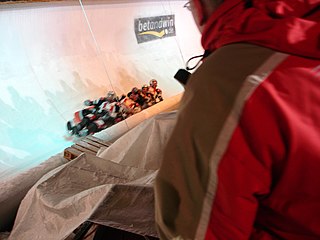
The Olympic Sliding Centre Innsbruck is a venue for bobsleigh, luge and skeleton located in Igls, Austria. The most recent version of the track was completed in 1975 and is the first permanent, combination artificially refrigerated bobsleigh, luge, and skeleton track, serving as a model for other tracks of its kind worldwide. It hosted the bobsleigh, luge, and skeleton competitions for the 2012 Winter Youth Olympics.

The Mt. Van Hoevenberg Olympic Bobsled Run is a venue for bobsleigh, luge and skeleton in the United States, located at the Lake Placid Olympic Sports Complex in Lake Placid, New York. This venue was used for the 1932 and 1980 Winter Olympics and for the only winter Goodwill Games in 2000. The third and most recent version of the track was completed in 2000 with the track hosting both the first FIBT World Championships and FIL World Luge Championships done outside of Europe, doing so in 1949 and 1983. In 2010 the bobsled track was listed on the National Register of Historic Places.

The Eugenio Monti Olympic Track was a bobsleigh and skeleton track located in Cortina d'Ampezzo, Italy. It was named after Eugenio Monti (1928–2003), who won six bobsleigh medals at the Winter Olympic Games between 1956 and 1968 and ten medals at the FIBT World Championships between 1957 and 1966. It was featured in the 1981 James Bond film For Your Eyes Only, held after the 1981 FIBT World Championships, before the track was shortened to its current configuration. In January 2008, after one last bobsleigh race tournament, the track was closed.
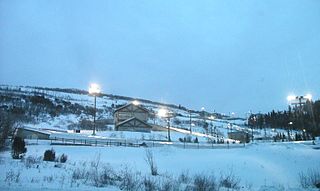
The Utah Olympic Park Track is a bobsleigh, luge, and skeleton track in the United States, located in the Utah Olympic Park near Park City, Utah. During the 2002 Winter Olympics in nearby Salt Lake City, the track hosted the bobsleigh, luge, and skeleton events. Today the track still serves as a training center for Olympic and development level athletes and hosts numerous local and international competitions. It is one of two national tracks; the other is at Mt. Van Hoevenberg near Lake Placid, New York.

The Spiral is a bobsleigh, luge, and skeleton track located in Iizuna village, located north of Nagano, Japan. Used for the bobsleigh and luge competitions for the 1998 Winter Olympics, it is the first permanent bobsleigh, luge, and skeleton track in Asia and the first of its type in the world with two or more uphill sections. It is officially referred to as the Nagano Bobsleigh-Luge Park in Japan.

The Sigulda Bobsleigh and Luge Track is located in Sigulda, Latvia, built in 1986. Currently, the track manager is Dainis Dukurs, former bobsleigh brakeman and the father of skeleton racers Martins and Tomass Dukurs.

The Whistler Sliding Centre is a Canadian bobsleigh, luge, and skeleton track located in Whistler, British Columbia, that is 125 km (78 mi) north of Vancouver. The centre is part of the Whistler Blackcomb resort, which comprises two ski mountains separated by Fitzsimmons Creek. Located on the lowermost slope of the northern mountain, Whistler Sliding Centre hosted the bobsleigh, luge, and skeleton competitions for the 2010 Winter Olympics.
The La Plagne bobsleigh, luge, and skeleton track is a bobsleigh, luge, and skeleton track located in La Plagne, France. The track was the venue for the bobsleigh and luge competitions for the 1992 Winter Olympics whose host city was neighboring Albertville.

For the 1980 Winter Olympics in Lake Placid, New York, United States, a total of seven sports venues were used. All five of the venues used for the 1932 Winter Olympics were also used at the 1980 Winter Games with adjustments. These adjustments included electronic scoreboards, increased refrigeration, and the addition of a separate luge track. This was the last Winter Olympics where there were separate bobsleigh and luge tracks. The closest finish in Olympic history in cross-country skiing led skiing officials to time future events in hundredths of a second rather than tenths of a second. This would also apply to biathlon events. Eric Heiden won five gold medals at the speed skating oval while the "Miracle on Ice" took place between Americans and Soviets at the Olympic Center. In the late 1990s, the luge track was demolished and a new combination track was constructed in time for the only Winter Goodwill Games held. The sliding venue was named to the American National Register of Historical Places in February 2010.

For the 1988 Winter Olympics in Calgary, Alberta, Canada, a total of nine sports venues were used. Calgary tried twice to host the Winter Olympics in the 1960s without success before finally winning the 1988 Winter Games in 1981. Stampede Corral was built in 1950 while McMahon Stadium was built in 1960. When the National Hockey League (NHL) Flames franchise was relocated from Atlanta, Georgia in the United States during the summer of 1980, a new arena was needed. The Saddledome construction was underway in late 1981 when Calgary was awarded the 1988 Games. Completed in 1983, the Olympic Saddledome has played host to the Flames ever since, including three Stanley Cup Finals and the NHL All-Star Game in 1985. An innovation for the games was the first indoor long-track speed skating venue which has served as a model for future Olympics. The bobsleigh and luge track was the first combination track in North America and was noted for the Jamaican bobsleigh team crash during the four-man event. Both the Oval and the bobsleigh/luge track continue to host the World Championships in their respective sports since the 1988 Winter Olympics.

Sarajevo Olympic Bobsleigh and Luge Track is a bobsleigh and luge track situated on Trebević mountain overlooking the City of Sarajevo, built for the 1984 Winter Olympics.























